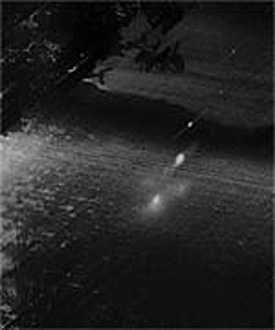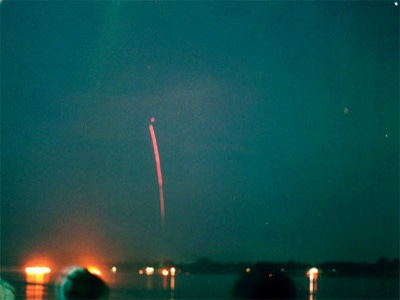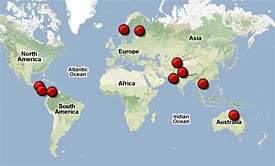Places with meteorological phenomena 🢔 Legendary wonders 🢔 Categories of wonders
Wonder
Naga fireballs of Mekong
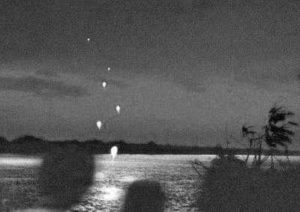
 In short
In short
Weird things are happening some 70 – 100 kilometres downstream from the Vientiane – capital of Laos. In the nights from the muddy waters of Mekong river appear red glowing balls which quickly rise up in the air and disappear without noise (some, who manage to be close to the lights, report silent hiss). These mysterious sparkles are small, but sometimes they reach the size of a basketball.
 42.3%
42.3%
GPS coordinates
Location, address
Alternate names
Name in Thai
Map of the site
If you see this after your page is loaded completely, leafletJS files are missing.
 In detail
In detail
Description
Fireballs are observed in some 250 kilometers long sector of Mekong: approximately from Ban Muang upstream from Vientiane down to Bung Kan. Most of them rise from the 500 – 800 m wide Mekong River, but they have been observed rising from smaller ponds and rivers as well. These places might sound exotic and remote to Europeans but they are densely populated, filled with houses, roads, schools, and other usual features of civilization.
These are not some ghosts seen by occasional people and questioned by majority. Ghost fireballs of Mekong have been seen by thousands of people, photographed and captioned on movies, and, after all, investigated by scientists looking for the explanation of this interesting phenomenon.
Phenomenon of Naga fireballs is not too well documented in earlier times. Some say that Wat Luang temple (in Phon Phisai, Wat Pho Luang Phra Sai) contains centuries-old written records mentioning them. There are mentioned also occasional written reports from British soldiers in the 1960s – although nothing concrete is cited. Numerous local people claim that they have seen the lights for all their lives and their parents and grandparents did it as well.
Although the appearance of fireballs is celebrated on certain days in October, in fact, this event is not predictable. There have been cases when the official festivity “ends without results” and fireballs come unexpectedly on another night. Many people have tried hard to see them for years without success, many are lucky and see them at the first visit to this site. For example, in 2001 there were reported 3,000 fireballs, the festivity of 2004 was disappointing in this respect but in 2008 the illumination was excellent.
Ghostly fireballs can be seen at different times of the year but most frequently they are in late October – early November when the long period of rains has ended and the Mekong is filled with lots of fast-flowing, muddy water.
Balls seem to be rising out of the water (some skeptics though say that it looks more like going up on the Laotian side of the river). They appear in different places, but sometimes several come out from a single place.
Phaya Naga – king of serpents
Since ancient times numerous people have been living along the Mekong. According to some reports, as recently as in the 1980s these balls of light attracted little attention from local people (3). It could be possible that there are some ancient myths related to this event which later have been nearly forgotten by local people and then somehow revived.
Whatever the history of this myth but one is clear – since the early 1990s Mekong fireballs gradually became famous and simultaneously there were attached myths to them. One of these myths:
One particular naga (a kind of snake or dragon) loved to crawl around the mountains right in the place where the Mekong flows today. This outstanding naga still continues to travel her usual route – now underwater and spits flames wherever it goes – as all respectable dragons do.
There is involved also Buddhism in this story, making it more complex – although local Buddhist monks seem to be spectators of the show and not active promoters of it. This "Buddhist" myth has involved the ominous Phaya Naga – serpent-king of the underworld – in making of these fireballs. Phaya Naga in this story turns out to be an ally of Buddha. Buddha and Phaya Naga in their mythical battles obtained a blessing for local people – regular periods of rain. As the rain ends, Buddha returns to Earth from heaven and Phaya Naga greets him with fireballs.
Festivity
There is a traditional and well-proven method to facilitate tourism anywhere in the world, which works especially well in southern Asia: if your locality happens to have some interesting natural phenomenon, find a religious explanation to this and organize yearly festivities to celebrate it.
In the case of Phon Phisai town in Thailand (and several other towns along the Mekong) naga fireballs have been perfectly well suited. Fireballs are most frequent at the end of October – thus exactly then is organized the religious Phaya Naga festival.
This coincides very well with an important event in the Buddhist calendar – the end of vassa: three months-long period of a kind of fasting. The end of vassa – Wan Awk Pansa – is a joyous festivity of the people of Isan (Northeast Thailand) and Laos. This festivity in a way marks the end of a long rain period. Staying out in the evening after the long rains finally is pleasant and the moon over the Mekong makes this time romantic.
Festivity is organized at a full moon. Somehow the determination of full moon has ended up in a situation where Thailand celebrates the festivity one day earlier than Laos. Lately, though the festivity is expanding and lasts for several days and nights.
According to locals, festivities have taken place here for many generations – but if there were any festivities before 1990, these were of truly local nature, not known elsewhere. But in the early 2000s, the festivity at the Mekong came into vogue.
Thus, at the end of every October tens of thousands of people flock to Phon Phisai and other Thai and Laotian towns along the Mekong. In 2002 – 2004 there were hundreds of thousands of people coming. They take the “best places” along the river.
Earlier people just walked at the bank of Mekong and looked at occasional fireballs rising up. Nowadays there is organized a festive program with the great Mekong in focus: in the river are floating beautiful illuminated boat processions and river receives offerings – mainly sweets. Numerous other events take place, as is usual in popular festivals.
But the main event is the appearance of fireballs. Thousands of people look with awe at them rising up in the air as fast as sparks from the campfire. On some nights thousands of such weird sparks rise out from the waters but sometimes – none. People cheer the lights with joy and feel happy to be together at this mystery.
Scientists get involved
Contrary to most of the other ghostly apparitions around the world, Naga fireballs have been observed by thousands of people and captured in numerous photographs and movies.
Most local people believe in the mythical explanation involving nagas. In 2002 there arose a scandal when independent Thai TV channel iTV reported that they observed the following: each time when Laotian soldiers shot some tracer bullets in the air, the Thai side of the river was greeting this with cheerful shouts. TV reporters thus proved that sometimes "fake" naga balls are greeted.
This report met with stiff resistance of local people expressing even hate towards iTV.
Government of Thailand decided that scientists should be involved to provide an explanation. A kind of "dreamteam" of Thai experts was established, at the same time raising heated debates about the intrusion of science in traditional myths.
In 2003 thermal scanners and five teams of scientists were stationed in several spots along the river in Rattanawapi district (Thailand). A team was located also at the most famous observation spot – at the Naga temple in Phon Phisai town. There were rumors about the involvement of specific submarines in research.
Some scientific reports mention an upward movement of gas bubbles in Mekong water. According to them – as the gas bubbles reached the surface, the gas started to burn and rose up like a glowing orange bubble.
Phosphine? Methane?
Earlier some scientists considered that the most likely reason for flames is phosphine (PH3). This gas, especially in the presence of the diphosphine (P2H4), is capable of spontaneous flammability. Thus one can assume that bubbles of this substance may arise from the sediments of Mekong and, as it reaches the atmosphere, burn with a yellow-orange flame. A small amount of this substance quickly is consumed in flames, and, as the burning bubble rises up in the air, it disappears.
Possible source of phosphine might be a chemical reaction in the river sediments – a bacterial reduction of phosphate in decaying organic matter.
Often is mentioned another gas – methane, which, theoretically, if mixed with the same phosphine and some other gases at very specific conditions may experience spontaneous ignition.
…or hoax?
There remained unsolved issues though:
- Phosphine is not a light gas, it is heavier than air. Naga lights though rise up in the air very quickly.
- When phosphine burns, it produces a dense, white, and highly toxic cloud. None of these effects (luckily) have been observed on Mekong.
Thus the hypothesis of phosphine is rejected and specialists focus more on other self-inflating gases: burning gas seems to be the most logical explanation for Mekong fireballs. But – even if scientists find another igneous gas rising from the sediments of Mekong – why don’t we observe a similar phenomenon elsewhere – in other tropical rivers and lakes? How can a bubble of gas rise up that quickly without being extinguished?
Some consider that these igneous gases are somehow pulled out of the river sediment by the full moon and some researchers even build up highly complex theories involving the specific composition of gases in sediments coupled with the action of the moon, ultraviolet rays, Sun, etc. All of this at the end looks too laborious and unlikely.
Also the imaginary organic sediments of Mekong seem not to exist – the river here, for the most part, has a sandy bed with occasional rocks.
Popular Thai movie "15 Kham Duan 11" ("The 15th of the 11th Lunar Month", made in 2002) offers another explanation – here Laotian monks place clay eggs on the river bed – these rise to the surface and there light up. There are though serious drawbacks in this fine movie, which seem to make this proposed explanation flawed (if art is taken seriously): more or less safe and controlled diving in this muddy, powerful river is nearly impossible with modern diving gear.
Often it is considered that fireballs are created artificially – just like some people find fun in making crop circles or other weird things. Now it is essential to keep the big festivities running – after all this event has been turned into a highly profitable show (but spread among huge local communities – which isn’t bad at all). One can easily see that there might be a commercial interest to "maintain" this phenomenon artificially.
In addition to this – some locals tell that in earlier times naga fireballs were much smaller and nearly white, they rose above the water just for a few meters. Now, with increased popularity, they somehow have evolved, increased in size, fly high and fast, and have an orange color. A bit heretical thought – maybe naga serpent has changed diet?
Hoax is impossible?
Locals deny a possibility of the hoax – naga fireballs often are observed in very secluded places where the putative "organiser" of fireballs has nearly no chances to impress anyone. It is just weird to imagine countless Thai and Laotian people keeping themselves busy by making illuminations in remote lakes and rivers.
Appearance of fireballs has been reported in more than 45 kilometers long section of river in one night. The river has been closely watched by numerous people for many days before. In such circumstances the possibility of fraud seems to be quite low – who would manage to organize such illumination without getting caught in the act?
Naga fireballs rose from the river during the hostilities between Thailand and Laos: the border was heavily guarded then and it is little likely that somebody would risk his life to organize the fraud.
Legend of modern times
Wondermondo will not present judgment about the source of naga balls. One should be recognized – if this is a hoax, it is organized very well and there are lots of people who are happy to believe in this.
But maybe naga fireballs are real, natural mysterious light effects – so-called Earthlights (see another example – Chir Batti)? Riddles posed by these phenomena are not that easy to solve.
References
- Highly critical view to Naga fireballs: The Naga Fireballs. Skeptoid, Critical Analysis of Pop Phenomena. Accessed in the 23rd September 2010.
- Thailand’s Naga Fireballs declared not supernatural. Originally published by The Nation, 12 October 2003. Accessed in the 23rd September 2010.
- Erik Cohen. Explorations in Thai Tourism. The "Postmodernization" of a Mythical Event: Naga Fireballs on the Mekong River. 2008.
Similar phenomena described by Wondermondo
- Hessdalen lights in Norway are balls of light often seen floating in Hessdalen valley. This phenomenon has been researched since 1983 but no explanation has been found thus far.
- Chir Batti in India, Gujarat are balls of light floating near the ground level around the plains of Banni grasslands. These lights were noticed here already in ancient times. There is no scientific explanation to this phenomenon.
- Paasselkä devils in Finland are light balls of unexplained origin. They are observed over the surface of Lake Paasselkä for at least 100 years.
Naga Fireballs of Mekong are included in the following article:
 Linked articles
Linked articles
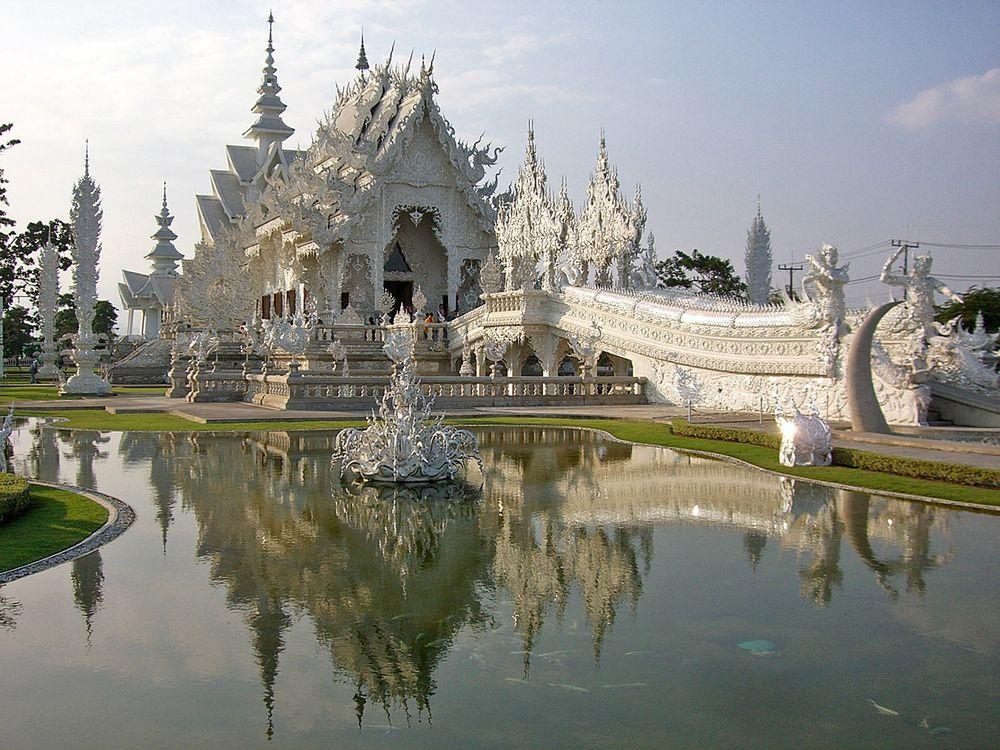
Wonders of Thailand
Thailand has been a tourist hotspot for decades but only lately visitors are turning their attention to the immense natural and cultural heritage of Thailand.
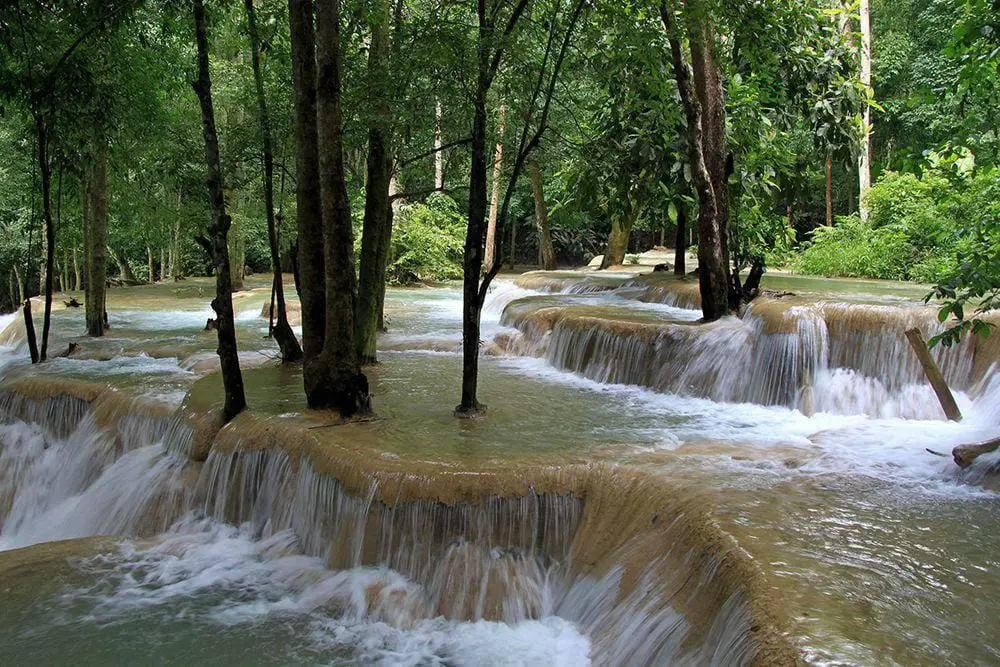
Wonders of Laos
Only in recent years has Laos been emerging on the stage of international tourism – this beautiful country for decades was dragged in terrible wars and post-war isolation period.
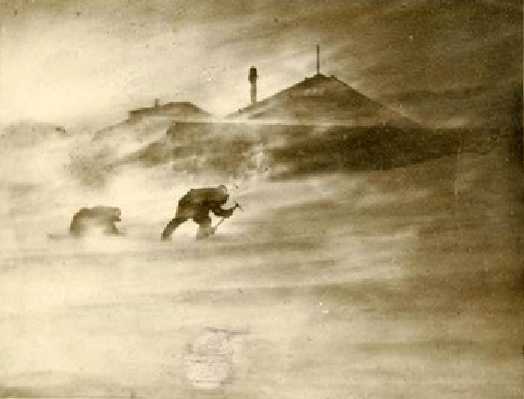
Meteorological phenomena
Unusual weather conditions can happen in any place in the world. But there are locations where unusual meteorological phenomena are observed frequently – even every day.
 Recommended books
Recommended books
Weather: The Ultimate Book of Meteorological Events
Weather: The Ultimate Book of Meteorological Events is a compilation of some of the most spectacular weather photography and writing in the world. Adapted from over 20 years of material from the bestselling Weather Guide calendar, this comprehensive volume combines dozens of essays from more than 20 meteorology and climate change experts.
Al Roker’s Extreme Weather
Dive deep into a world of fascinating weather with everyone’s favorite meteorologist, Al Roker!
With this mesmerizing book that covers a wide range of topics, readers will learn about the conditions that generate unique weather occurrences like red sprites, thundersnow, and fogsicles.

